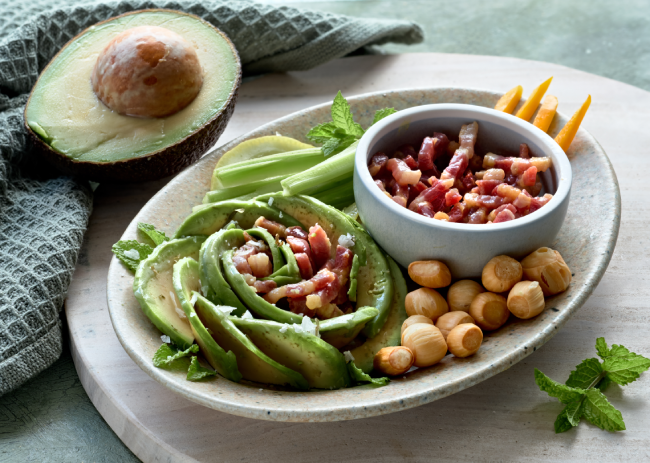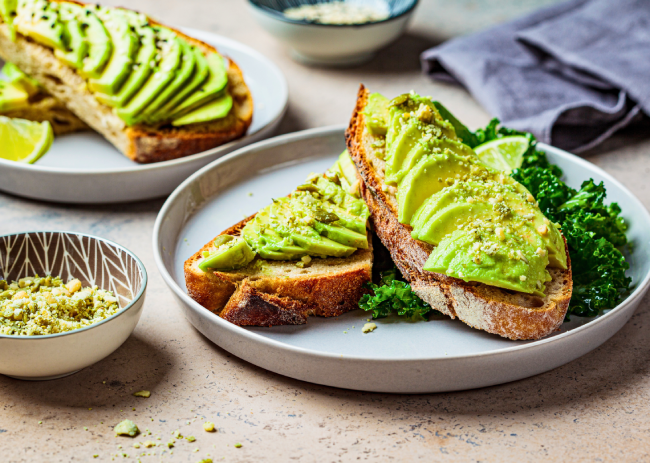Introduction to Healthy, Clean Keto
Clean keto is a health-focused method of following the ketogenic diet that combines the keto diet’s macronutrient ratio with the paleo diet’s good nutrient density.
The advantages of this eating style are that you consume more nutrients, giving your body more of the vitamins and minerals needed to improve every aspect of your health. This includes digestion, mood, brain function, and even skin and hair. This way of eating prioritizes healthy food options over dirty keto, another variation of the keto diet that takes a much more lax approach and focuses on convenience foods that are frequently deficient in micronutrients.
For lunch, a clean keto approach might entail choosing healthier options like fish with a side salad drizzled with a C8 MCT oil dressing, as opposed to fast food like a bun-less bacon cheeseburger.
What Are the Advantages of a Clean Keto Diet?
Clean keto can provide several long-term health advantages over other approaches. This eating style will enable you to get the most out of the keto diet regarding weight loss, health, and overall well-being. Listed below are just a few advantages of the clean keto diet:
▪ Smooth digestion
▪ Steady energy levels
▪ Increased concentration
▪ Long-term vigor
▪ Enhanced metabolism
▪ Steady weight loss
▪ Better skin health
▪ Greater immunity
▪ Improved mood
Clean keto offers its devotees additional macronutrients, fiber, and potent anti-inflammatory advantages by emphasizing the consumption of complete foods. It’s a sustainable option that aids in losing extra weight while enhancing general physical and mental wellness.
Tips for Keto Clean Eating
You may improve your keto eating habits and get the most benefits for your health and weight loss by following these easy guidelines:
Substitute Processed Foods for Whole Foods
Your favorite fast food restaurant’s bun-less bacon cheeseburger can pass for keto-friendly, but it is deficient in vital micronutrients for good health. Additionally, packaged junk food like this is frequently loaded with unhealthy additives, preservatives, and sodium.
A diet heavy in processed foods can harm your health by resulting in various unwelcome digestive issues like leaky gut, protracted keto flu symptoms, and low energy. Additionally, it can stop or slow down positive outcomes like improved energy, fat loss, and more excellent skin health.
Clean keto prioritizes your long-term health, and it recognizes the value of being mindful of where you get your nutrients and fats from. Try substituting a bacon cheeseburger from your neighbourhood fast food restaurant for a homemade grass-fed burger topped with local full-fat cheese and nitrate-free bacon from your farmer’s market! Such excellent quality protein will also help you to gain muscle on keto, like this page explains.
Choose Healthy Fats
There are various sources of fat and not all are good, so bear that in mind as you search for foods that will maintain you in a state of ketosis.
Healthy fat is defined as fat that reduces inflammation in the body. Two examples of excellent sources of these fats are polyunsaturated and monounsaturated fats.
Pure keto fats consist of the following:
▪ Fish like salmon, cod, herring, trout, and sardines
▪ Nuts such as almonds, hazelnuts, pecans, brazil nuts, macadamia nuts, and walnuts
▪ Avocado
▪ Flax seeds
▪ MCT oil
▪ Hemp hearts
▪ Algae
▪ Coconut oil
▪ Ghee
▪ Sesame oil
Unhealthy fats increase inflammation in the body, raising the risk of type 2 diabetes and other adverse effects like insulin resistance and heart disease.
Trans fats are one form of fat that should be avoided. They are heavily processed and can lower your HDL cholesterol while raising your “bad” LDL cholesterol. The Food and Drug Administration has recommended that one type of trans fat, partly hydrogenated vegetable oil, be phased out over the next few years since it is thought to be dangerous.
Industrial oils, such as vegetable oil, canola oil, maize oil, soybean oil, and cottonseed oil, are other sources of bad fat that should be avoided. The body’s ratio of omega 3 to omega 6 necessary fatty acids is thrown off by these highly processed, frequently rancid oils, which can result in chronic inflammation.
Canola oil, vegetable oil, soybean oil, corn oil, cottonseed oil, rapeseed oil, peanut oil, processed cheese, and palm oil are unhealthy keto fats to stay away from.
Eat Your Veggies
The simplest method to achieve your recommended intake of vitamins, minerals, and fiber is by including veggies in your meals.
You won’t just avoid suffering from keto constipation thanks to fiber. Vegetables high in fiber can also help you feel full for a long time because they absorb a lot of water and take longer to digest.
You can reduce your daily calorie intake by an average of 22% by eating enough fiber, which promotes weight loss. Additionally, fiber helps to control blood sugar levels, which reduces cravings.
Here are some high-fiber, low-carb vegetables you may use in your keto diet:
▪ Broccoli
▪ Avocado
▪ Asparagus
▪ Kale
▪ Spinach
▪ Bell peppers
You’re giving your ample body amounts of vital micronutrients, vitamins, and minerals that will maintain your physical and mental wellness by eating your fair share of vegetables.
Avoid Artificial Sweeteners
With the keto diet, we have a huge variety of sugar substitutes. Unfortunately, artificial sweeteners, the most widely used substitute in sugar-free items on the market, can harm gut health by eradicating gut-friendly bacteria and interfering with blood sugar stability.
The harmful effects of artificial sweeteners include:
▪ Headaches
▪ Interfere with behavior, mood, and brain functioning
▪ May be carcinogenic
▪ Increase hunger and blood sugar levels
▪ Loss of beneficial gut bacteria
Sadly, even keto-friendly Starbucks beverages are no exception because these artificial sweeteners are among the most frequent components in sugar-free coffees. Thankfully, you can duplicate your favorite latte drinks without gut-harming sweets by choosing one of the numerous clean keto options available. For example, you can look for GI-friendly, low-glycemic natural sweeteners like stevia and monk fruit.
Select Organic and Grass-fed Meat
Choosing processed meats like hotdogs can lead to intestinal irritation. Instead, choose grass-fed and organic beef, which has more vitamins and better-saturated fats, for a balanced meal that will fill your stomach and make you feel satisfied. Grass-fed meat is five times more enriched in omega-3 fatty acids, vitamins A and E, and digestive enzymes like glutathione, compared to grain-fed cattle.
Another healthy choice that can enhance your intake of vital vitamins and minerals is wild-caught fish. Wild-caught rather than farm-raised fish are higher in nutrients like vitamin D and omega 3 and it’s produced without antibiotics.
Clean keto provides healthier options for dairy too. Grass-fed dairy is the cream of the crop because it contains many more vitamins, minerals, antioxidants, and healthy fats than other types of dairy.
Organic, grass-fed cows are more nutrient-dense than their corn- and grain-fed counterparts and have higher concentrations of conjugated linoleic acid (CLA). This is an omega-6 that can considerably boost your metabolism while addressing inflammatory conditions like asthma and allergies.
Your daily intake of the crucial omega-3 fatty acids that improve focus and memory recall will increase if you choose dairy brands that obtain their products from organic, grass-fed cows.
Make Straightforward, Homemade Keto Meals
Keto dieters who lead hectic lives are well aware of the temptation to choose fast food meals suitable for their diet. While selecting these bad keto foods may not initially have a discernible impact, they eventually bring about long-term adverse effects that make it harder and harder to lose each pound.
Thankfully, preparing a clean keto meal at home doesn’t have to take long. You benefit from completely controlling your diet when you cook at home. Salmon and a side salad cooked with
a handful of leafy greens, a few slices of Avocado, and a simple C8 MCT oil dressing are an example of an easy, tasty clean keto dinner.
Modify Your Mentality
The keto diet promotes weight loss by emphasizing cutting back on carbohydrates and upping your intake of fats. However, paying too much attention to these macronutrients might occasionally cause us to overlook the most important things: your long-term health and feeling your best.
We have discussed many tips and tricks about how to go about a clean keto diet plan, with numerous examples of food items you can incorporate into your diet. Now we’ll give you an insight into some of the best clean keto recipes that you can make right now.
Clean Keto Meal Recipes
Shepherd’s Pie
Ingredients:
For beef filling:
✔ 1 cup beef broth
✔ 1/3 cup baby carrots, chopped
✔ 2 pounds of ground beef
✔ 1 cup mushrooms
✔ 2 tablespoons tomato paste
✔ 2 garlic cloves, minced
✔ 1 tablespoon ghee
✔ 1 ½ tablespoon balsamic vinegar
✔ 1 small yellow onion, chopped (½ cup)
✔ 1 14.5 oz. can cut green beans (drained)
✔ 1 teaspoon dried thyme
✔ 1 ½ tablespoon Italian seasoning
✔ 1 teaspoon salt
✔ ½ teaspoon pepper
✔ ½ teaspoon xanthan gum
✔ Fresh parsley for garnish
Cauliflower mash topping:
✔ 3 12 oz. bags of cauliflower rice (or 1 head of cauliflower)
✔ 1 tablespoon ghee
✔ ½ teaspoon black cracked pepper
✔ 2 tablespoons canned coconut milk (unsweetened)
✔ 1 teaspoon garlic powder
✔ 1 teaspoon salt (more or less to taste)
✔ 1 ½ tablespoons chives (fresh or dried)
Preparation:
- Set the oven to 400 degrees Fahrenheit.
- Pour the ghee into a 12-inch-diameter cast iron skillet and heat it for 2 minutes. Include the garlic and onions. Cook for 4 minutes while occasionally stirring.
- Add the ground beef to the skillet and, using a wooden spoon, break it up. Stirring regularly, cook the meat for 6 to 8 minutes or until it is browned.
- After the beef has been browned, add the mushrooms, diced carrots, and drained green beans. With a wooden spoon, combine everything and heat for about 4 minutes.
- Include tomato paste, beef broth, xanthan gum, dried thyme, Italian seasoning, and balsamic vinegar. Stir until the tomato paste is completely mixed and no clumps are visible.
- Boil the liquid/meat mixture for a few minutes before simmering for 5 minutes while stirring periodically.
- Steam 2 bags of cauliflower rice in the microwave for 10 minutes or bring 1 head of cauliflower to a boil. Drain the liquid from the cauliflower and add it, along with the chives, garlic powder, coconut milk, ghee, salt, and pepper, to the food processor.
- Blend ingredients until smooth, then sprinkle with fresh chives. A soupy puree will result from over-blending. Be careful not to do this. Place the cauliflower mash in a bowl and top with the ghee, chives, salt, and pepper.
- Turn off the heat under the cast iron skillet. Over the meat mixture, carefully spoon the cauliflower mash in a uniform layer.
- Bake for 25 to 30 minutes uncovered. For a lovely crisp on the top, turn on the broiler for the final three minutes. Watch it carefully to prevent burning.
- Dish out and savor!
Nutrition (per serving)
| Calories | 283 |
| Fat | 9g |
| Carbs | 13g |
| Protein | 40g |
Zucchini Noodles With Avocado and Baked Eggs
Ingredients:
✔ Nonstick spray
✔ 3 zucchinis, spiralized into noodles
✔ 2 tablespoons extra-virgin olive oil
✔ Salt and freshly ground black pepper
✔ 4 large eggs
✔ Red pepper flakes for garnishing
✔ Fresh basil for garnishing
✔ 2 avocados, halved and thinly sliced
Preparation:
- Set the oven’s temperature to 350°F. Apply nonstick spray to a baking sheet to lightly oil it.
- Combine the zucchini noodles and olive oil in a big bowl. Add salt and pepper to taste. 3. Make each portion into a nest on the baking sheet, then divide evenly into 4 pieces.
- Insert a cracked egg carefully in the middle of each nest. Bake for 9 to 11 minutes or until the eggs are set.
- Add red pepper flakes and basil to garnish after seasoning with salt and pepper.
- Serve with slices of avocado.
Nutrition (per serving)
| Calories | 633 |
| Fat | 53g |
| Carbs | 27g |
| Protein | 20g |
Roast Chicken Thighs With Carrots
Ingredients:
✔ 4 chicken thighs
✔ 1½ pounds carrots, peeled and trimmed
✔ 1 large onion, peeled and cut into eighths
✔ 1 head of garlic
✔ 4 tablespoons olive oil
✔ 1 tablespoon chopped fresh rosemary
✔ Salt and freshly ground black pepper, to taste
Preparation:
- Set the oven’s temperature to 425°F.
- Spread the carrots and onion out in a single layer on a baking sheet that has been oiled.
- Cut the top off a head of garlic, throw it away, and set the head of garlic on the tray. 4. Season the veggies with salt, pepper, rosemary, and two tablespoons of olive oil.
- Add the chicken thighs on top. Add salt and pepper and rub 1 teaspoon olive oil into each thigh.
- Roast in the oven for 15 to 20 minutes or until the chicken skin is brown and the carrots are soft.
- Distribute the chicken thighs and vegetables among the four dishes to serve.
Nutrition (per serving):
| Calories | 553 |
| Fat | 39g |
| Carbs | 24g |
| Protein | 37g |
Garlic Shrimp With Zucchini Noodles
Ingredients:
✔ 1 medium zucchini
✔ ½ pound medium shrimp peeled & deveined
✔ ½ tablespoon olive oil
✔ Juice and zest of 1 lemon
✔ 2 cloves minced garlic
✔ Red pepper flakes
✔ Salt & pepper to taste
✔ Chopped fresh parsley
Preparation:
- Spiralize the zucchini in a medium setting. Place aside.
- Place a skillet over medium heat and add the olive oil, lemon juice, and zest. Add the shrimp once the pan is hot. For one minute on each side, cook the shrimp.
- Include red pepper flakes and garlic. Stirring frequently, cook for a further minute.
- Add the zucchini noodles and continue stirring or tossing (with tongs, for example) until they are heated and cooked.
- Add the chopped parsley and season with salt and pepper. Serve right away.
Nutrition (per serving):
| Calories | 276 |
| Fat | 11g |
| Carbs | 9g |
| Protein | 38g |
Clean Meatballs
Ingredients:
✔ 2 lbs ground beef
✔ 1 large egg
✔ 1/2 tsp ground ginger
✔ 1/2 tsp sea salt
✔ 1/2 tsp ground black pepper
✔ 1/3 cup chopped onions
✔ 1/2 cup almond flour (add more if needed)
✔ 1 tbsp coconut aminos
✔ 1/2 tsp garlic powder
✔ green onions (chopped, for garnish)
Sticky Sauce
✔ 1 cup coconut aminos
✔ 1/2 cup rice vinegar
✔ 2 1/2 tbsp water
✔ 1 clove garlic (minced)
✔ 2 tsp sesame seed oil
✔ 1/2 tsp ground ginger
✔ 2 tsp teaspoons arrowroot powder
✔ 1 tbsp honey
If you are sensitive to salt, you might only want to use 1/4 tsp instead of 1/2 tsp or leave out the salt entirely. Coconut aminos already have a substantial saltiness. So, exercise good judgment. If the sauce needs to be tamed, you may simply add a little bit more water.
Preparation:
- Grease a baking sheet with cooking spray or olive oil and preheat the oven to 400 degrees F.
- Combine all the ingredients for the meatballs in a bowl.
- Create meatballs the size of a golf ball out of the mixture. Each meatball should be put on a sheet pan. Bake for 20 to 25 minutes or until thoroughly done.
- Place all sauce ingredients in a skillet over medium-high heat, except the arrowroot flour (substitute with tapioca flour if necessary). Add the arrowroot flour dissolved in water after the liquid is heated. Frequently stir. The sauce will start to thicken as it warms (this may take a few minutes).
- Add the cooked meatballs to the sauce and stir to combine for a little while.
- Spoon the dish over cauliflower rice and top with sesame seeds and green onions.
Nutrition (per serving):
| Calories | 421 |
| Fat | 7g |
| Carbs | 11g |
| Protein | 30g |
Mushroom Chicken
Ingredients:
✔ 1/4 cup butter
✔ 2 cups mushrooms, sliced
✔ 1/4 teaspoon black pepper
✔ Four large chicken thighs
✔ White cooking wine ½ cup (substitute with chicken broth if needed)
✔ 1/2 teaspoon garlic powder
✔ 1 teaspoon salt
✔ 1/2 cup water
✔ 1/2 teaspoon onion powder
✔ Swiss cheese (3-4 slices)
Preparation:
- Melt 1 tablespoon of the butter in a cast-iron or heavy-bottomed sauté pan.
- For 3 to 4 minutes on each side, sear the chicken thighs on both sides until they
are golden brown.
- Chicken should be taken out of the pan and put aside.
- Then we add white cooking wine or chicken broth, butter, garlic, and mushrooms, and let the mushrooms simmer and the liquid diminish.
- Add butter and cream when the liquid is almost gone to make a decadent keto mushroom sauce.
- Re-add the chicken to the skillet, sprinkle the Swiss cheese on top, cover the pan, and let the food simmer so the flavors can mingle.
- This will make a total of 2-3 servings.
Nutrition (per serving 1 chicken thigh and ¼ cup mushroom):
| Calories | 447 |
| Fat | 31g |
| Carbs | 3g |
| Protein | 37g |
The bottom line
The macronutrient requirements for clean keto are the same as for normal keto, but there is more emphasis on nutrient-dense real foods than on processed meals. You may boost your mood, energy levels, and health while losing weight by cutting out “dirty keto” fast food and artificial sweeteners and focusing more on low-carb fruits, vegetables, high-quality meat, and dairy. Enjoy!




